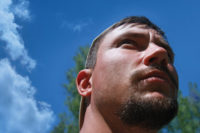- Move outside jobs inside or to a shady location, if possible. Erect a temporary shelter or use trees and buildings for protection.
- Have a shady spot available for lunch and coffee breaks.
- Reorganize job tasks so those requiring outdoor work get done before 10 a.m. and after 4 p.m.
- Wear protective clothing and cover the skin.
- Avoid clothes you can see light through. If light is getting through, the ultraviolet radiation is getting through as well.
- A collar will protect the skin on the back of the neck.
- Wear a hat and sunglasses
- Broad-brimmed hats are best. The brim should be at least 3 inches wide.
- If a lot of bending is required, have a flap on the back of the hat to keep sun off the back of the neck.
- Hardhats can have a flap or extra brim fitted to them.
- Use sunglasses or safety glasses that filter out UV rays.
- Use an SPF 15 or higher sunscreen before going outdoors. (see sidebar)
- Use water-resistant sunscreen when working with water or when perspiring.
- Some substances increase the harmful effects of ultraviolet radiation. These include industrial chemicals such as asphalt and diphenyls, and some medications. A water-resistant sunscreen will help give protection when there is likely to be skin contact with these substances.
- Reapply sunscreen every two hours. If sweating freely, reapply more often.
- Make sure the face, lips, neck, ears, arms and back of the hands are protected.
- Ultraviolet radiation bounces off water, sand, concrete, light-colored surfaces and snow. People who work near these areas will need to take extra care.
What you need to know about sunscreen
Sunscreens combine several ingredients that help prevent the sun’s ultraviolet (UV) radiation from reaching the skin. Two types of ultraviolet radiation, UVA and UVB, damage the skin and increase your risk of skin cancer. Sunscreens vary in their ability to protect against UVA and UVB.
What are UVA and UVB?
Ultraviolet (UV) radiation is part of the electromagnetic (light) spectrum that reaches the earth from the sun. It has wavelengths shorter than visible light, making it invisible to the naked eye. Ultraviolet A (UVA) is the longer wave UV ray that causes lasting skin damage, skin aging, and can cause skin cancer. Ultraviolet B (UVB) is the shorter wave UV ray that causes sunburns, skin damage, and can cause skin cancer.
What is SPF?
SPF – or Sun Protection Factor – is a measure of a sunscreen’s ability to prevent UVB from damaging the skin. If it takes 20 minutes for your unprotected skin to start turning red, using an SPF 15 sunscreen theoretically prevents reddening 15 times longer – about five hours. Most sunscreens with an SPF of 15 or higher do an excellent job of protecting against UVB.
What does broad-spectrum mean?
Broad-spectrum sunscreens protect the skin from both UVA and UVB rays. Beginning in December 2012, the U.S. Food and Drug Administration (FDA) began to implement new rules for “broad-spectrum” products.
Source: Skin Cancer Foundation, www.skincancer.org







